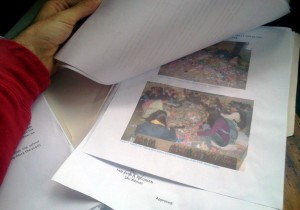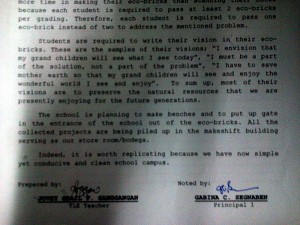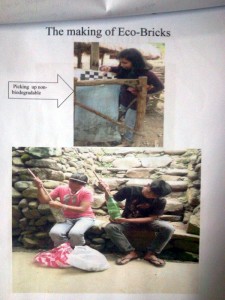On the desk of Irene Bakisan sit two massive folders. “Its not often we hear good news about basura. But all this is good news”. She waves her hand over the dozens and dozens of reports that have been coming in to her office in DepEd from schools around mountain province.
“This is exciting stuff.”
The situation was once dire in Paracelis. SSG Adviser, Methelyn C. Wacnang from Paracelis National Highschool describes in her report the streets and fields filled with discarded plastics before Ecobricks. Before, folks were forced to dump and even burn their plastic. However, “A week after the implementation of the VEBs in the school, a big change could be seen in the community. Seldom can we see now plastic wrappers scattered everywhere. It minimized non-biodegradable materials in the environment that causes pollution in the air, land and water”
Jovi Ganggangan from Betwanga National High School reports “Ecobricks have cleaned up dirt on pathways, at home… and even the river bank… We now have a simple yet conducive solution and clean campus. ”
“These schools, which are testing out a solid waste solution on a scale never before tried on the planet, are setting the example for us all” says Russell Maier, a Canadian based in Sabangan, and one of the architects behind the Ecobrick technology.
Indeed, according to Jovi, “In the community parents are also involved in reducing and reusing plastic since they are the ones who are making the ecobricks of their children, especially the younger children.”
According to Tessie a fourth year student at Mabay NHS, Ecobricking even brings people together for healthy bonding. “Instead of playing video games, drinking or smoking the students now sit around packing bottles and telling stories”.
A walk through the street in Poblacion Sagada reveals virtually every shop and restaurant with a half full Ecobrick being packed. What was once dumped and burned as ‘trash’ is now used as building blocks. Students from Sagada National Highschool describe with pride the stair-case they are building. Schools like Lagan Elementary, Sadanga NHS, and Guina’ang Elementary are being encouraged by their councilors, barangay captains, and mayors who are helping with expenses for construction.
“These students are solving solid waste where we adults have not been able to. I support them in whatever way I can.” says Coucilor Ernesto from Sabangan.
“We are teaching kids a whole new way to think about their trash. Indeed, its no longer trash, its a resource that we should segregate and can put to use to make bricks for our schools and gardens” says Irene.
There are dangers however. Some teachers report an increase in soft-drink and junk food consumption as students rush to fill their bricks. Other teachers report that students are so eager to make ecobricks that they put it before their homework. Others report that there are no more bottles to sell to junk buyers.
“Its really great that teachers and principals are seeing the challenges.” says Russell. “With a little guidance the students are reminded about the bigger picture. This isn’t about finishing a certain amount of bricks. Its about shifting our lifestyles into harmony with our environment.”
The youth understand. Many teachers asked their students to reflect on the plastics as they were putting them in the bottles and compose a vision or prayer for their community. Ecobrick making is a laborious, monotonous and meditative activity. Its a great moment to reflect on our wastes. Students wrote their visions for the environment of their community on their Ecobrick.
Here are several visions from Betwangan NHS Students:
“I envision that my grand children will see and enjoy the wonderful nature that I see and enjoy.”
Another student writes: “My vision is for the environment to be free of dirt, thereby making all the people in the community safer and happier”
“My prayer is that the next generation will see and enjoy our natural resources and help in preventing climate change that causes global warming and super typhoons.”
According to Irene Bakisan, in the first two months that the reports cover, there were 611 bottles made by elementary students and 1429 Eobrick from the high schools. Guina’ang Elementary, which has been collecting for almost a year, is now closing on 4000 Ecobricks.
Irene, picks up another report that has come in late from Tadjian Elementary. She smiles. Another school has completed several hundred bricks. “Its not the number that makes me happy. Its knowing that the new generation has begun a long term habit that will make a big difference for us and our grandchildren.”





